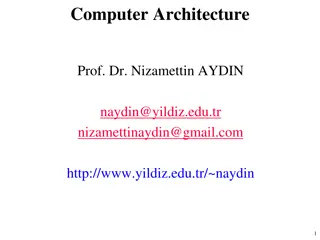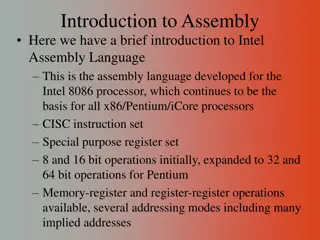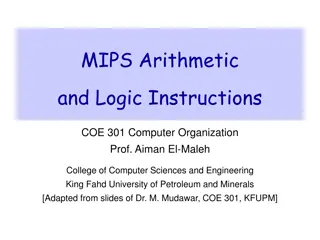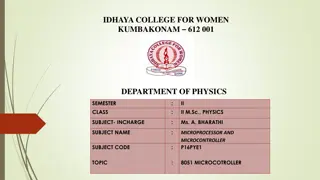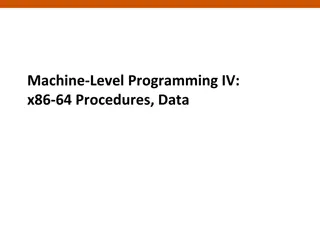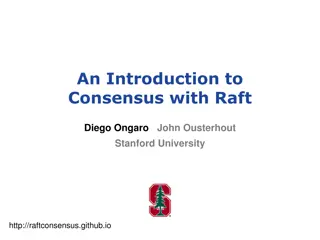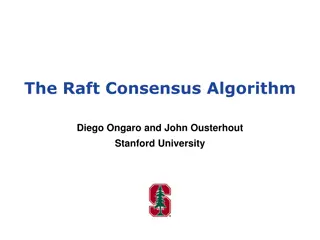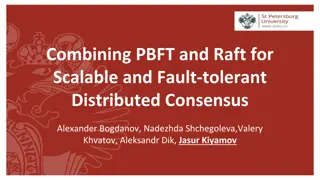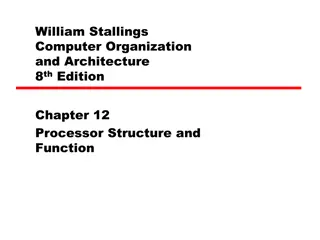Gryff: Unifying Consensus and Shared Registers
This presentation delves into the integration of consensus and shared registers for fault tolerance and linearizability, highlighting the importance of strong synchronization and low read tail latency. It explores various systems and interfaces such as Cloud Spanner, SMR, and shared registers, discussing their functionalities and implications.
Download Presentation

Please find below an Image/Link to download the presentation.
The content on the website is provided AS IS for your information and personal use only. It may not be sold, licensed, or shared on other websites without obtaining consent from the author.If you encounter any issues during the download, it is possible that the publisher has removed the file from their server.
You are allowed to download the files provided on this website for personal or commercial use, subject to the condition that they are used lawfully. All files are the property of their respective owners.
The content on the website is provided AS IS for your information and personal use only. It may not be sold, licensed, or shared on other websites without obtaining consent from the author.
E N D
Presentation Transcript
Gryff: Unifying Consensus and Shared Registers Matthew Burke Audrey Cheng Wyatt Lloyd Cornell University Princeton University 1
Applications Rely on Geo-Replicated Storage Fault tolerant: data is safe despite failures Client 2
Applications Rely on Geo-Replicated Storage Fault tolerant: data is safe despite failures Linearizable: intuitive for application developers 3
Linearizable Replicated Storage Systems Cloud Spanner Cloud Spanner 4
Status Quo: Consensus or Shared Registers Given the desire for fault tolerance and linearizability Consensus Shared Registers Strong Synchronization Low Read Tail Latency Unify consensus and shared registers? 5
Consensus & State Machine Replication (SMR) Generic interface: Command(c(.)) Stable ordering: all preceding log positions are assigned commands Used in etcd, CockroachDB, Spanner, Azure Storage, Chubby c1c2c3 c4 6
SMR Requires Stable Order Allow for strong synchronization primitives like read-modify-writes High tail latency in practice (e.g., by serializing through a leader) Consensus Strong Synchronization Low Read Tail Latency 7
Shared Registers Simple interface: Read()/Write(v) Unstable ordering: total order without pre-defined positions Similar to Cassandra, Dynamo, Riak w1< w2< w3< w4 w5 8
Shared Registers Use Unstable Order Cannot implement strong synchronization primitives [Herlihy91] Flexibility of unstable order provides favorable tail latency Consensus Shared Registers Strong Synchronization Low Read Tail Latency 9
Shared Objects: Interface for Unification Interface: Read()/Write(v)/RMW(f(.)) RMW(f(.)) read base v, compute new value f(v), write f(v) Examples: etcd, Redis, BigTable Unify consensus and RMWs with low read tail latency? shared registers? 10
Consensus-after-Register Timestamps (Carstamps) Unstable Order Stable Order w1 < < w5< < < w2 w3 w4 w6 rmw1 rmw3 rmw4 rmw2 11
Carstamps Tuple with three fields: (ts, id, rmwc) ts and id basis for unstable ordering of writes rmwc is set to 1 greater than rmwc of base to ensure stable ordering w1< w2 (3,1,0) (4,1,0) (4,1,1) (3,1,1) rmw3 rmw1 (3,1,2) rmw2 12
Gryff Unifies Consensus and Shared Registers Only uses consensus when necessary, for strong synchronization Consensus Shared Registers Gryff Strong Synchronization Low Read Tail Latency 13
Gryff Design Combine multi-writer [LS97] ABD [ABD95] & EPaxos [MAK13] Modifications needed for safety: Carstamps for proper ordering Synchronous Commit phase for rmws Modifications for better read tail latency: Early termination for reads (fast path) Proxy optimization for reads (fast path more often) See the paper for details! 14
Gryff in Action w1 (3,1,0) c1 Writes always terminate in 2 phases (2,3,0) (1,0,0) (2,3,0) 15
Gryff in Action w1 (3,1,0) c1 Writes always terminate in 2 phases (3,1,0) (2,3,0) (3,1,0) (1,0,0) (2,3,0) 16
Gryff in Action PreAcceptOK (3,1,0) PreAccept (3,1,0) c1 Writes always terminate in 2 phases RMW carstamps directly after base rmw1 (3,1,0) (3,1,0) (2,3,0) c2 17
Gryff in Action Executed (3,1,1) Commit (3,1,0) c1 Writes always terminate in 2 phases RMW carstamps directly after base (3,1,1) rmw1 (3,1,1) (3,1,0) (3,1,1) (3,1,0) (2,3,0) c2 18
Gryff in Action (3,1,1) r Read1Reply (3,1,1) Read1 c1 Writes always terminate in 2 phases RMW carstamps directly after base (3,1,1) (3,1,1) (2,3,0) Reads often terminate in 1 phase c2 19
Evaluation Relative to state-of-the-art-consensus protocols: 1. How do Gryff s read/write protocols affect read tail latency? 2. What is the latency distribution of Gryff s reads, writes, and rmws? 3. What maximum throughput does Gryff achieve? 4. How does Gryff perform in tail-at-scale workloads? 20
Evaluation Relative to state-of-the-art-consensus protocols: 1. How do Gryff s read/write protocols affect read tail latency? 2. What is the latency distribution of Gryff s reads, writes, and rmws? 3. What maximum throughput does Gryff achieve? 4. How does Gryff perform in tail-at-scale workloads? 21
Evaluation Setup Geo-replication with 3 regions 72ms 88ms not-to-scale ocean Baselines: MultiPaxos (industry standard), EPaxos (leaderless) 22
Read Tail Latency (94.5% R, 4.5% W, 1% RMW, 25% Conflicts) 1 Fraction of Reads 0.8 0.6 0.4 MultiPaxos 0.2 0 60 120 Latency (ms) 180 240 23
Read Tail Latency (94.5% R, 4.5% W, 1% RMW, 25% Conflicts) 1 serializing through far-away leader Fraction of Reads 0.8 0.6 0.4 MultiPaxos 0.2 0 60 120 Latency (ms) 180 240 24
Read Tail Latency (94.5% R, 4.5% W, 1% RMW, 25% Conflicts) 1 Fraction of Reads 0.8 delaying reads that conflict with concurrent writes 0.6 MultiPaxos EPaxos 0.4 0.2 0 60 120 Latency (ms) 180 240 25
Read Tail Latency (94.5% R, 4.5% W, 1% RMW, 25% Conflicts) 1 1 round to nearest majority in tail Fraction of Reads 0.8 0.6 MultiPaxos EPaxos Gryff 0.4 0.2 0 60 120 Latency (ms) 180 240 26
Summary Consensus: strong synchronization w/ high tail latency Shared registers: low tail latency w/o strong synchronization Carstamps stably order read-modify-writes within a more efficient unstable order for reads and writes Gryff unifies an optimized shared register protocol with a state-of-the-art consensus protocol using carstamps Gryff provides strong synchronization w/ low read tail latency 27
Image Attribution Griffin by Delapouite / CC BY 3.0 Unported (modified) etcd CockroachDB Spanner by Google / CC BY 4.0 29




